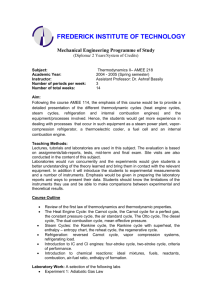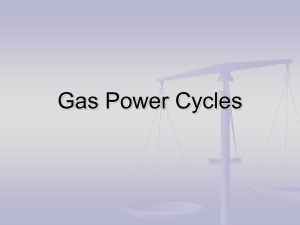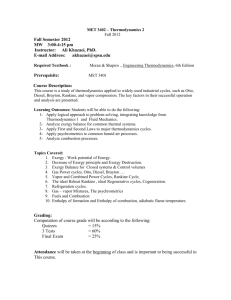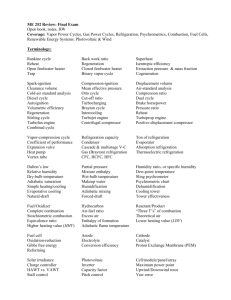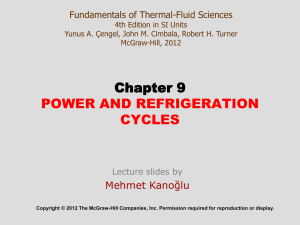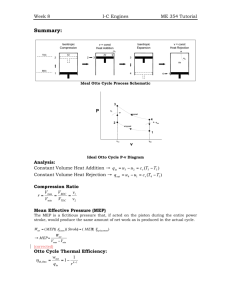Otto, Brayton and Rankine Cycles
advertisement
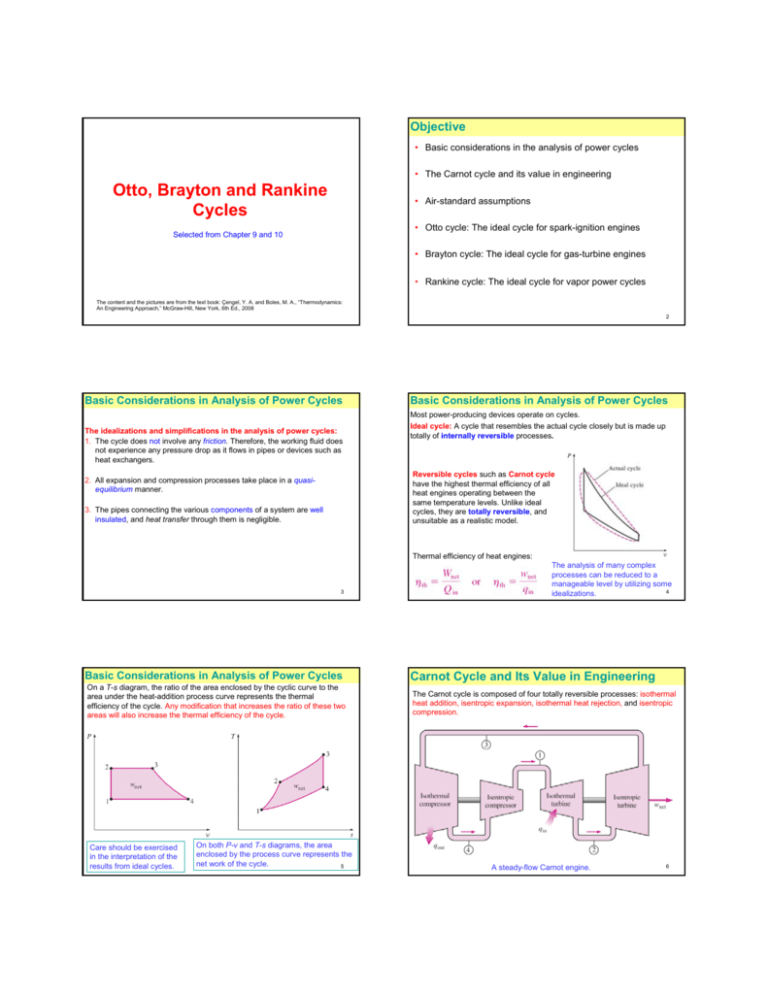
Objective • Basic considerations in the analysis of power cycles • The Carnot cycle and its value in engineering Otto, Brayton and Rankine Cycles • Air-standard assumptions • Otto cycle: The ideal cycle for spark-ignition engines Selected from Chapter 9 and 10 • Brayton cycle: The ideal cycle for gas-turbine engines • Rankine cycle: The ideal cycle for vapor power cycles The content and the pictures are from the text book: Çengel, Y. A. and Boles, M. A., “Thermodynamics: An Engineering Approach,” McGraw-Hill, New York, 6th Ed., 2008 2 Basic Considerations in Analysis of Power Cycles The idealizations and simplifications in the analysis of power cycles: 1. The cycle does not involve any friction. Therefore, the working fluid does not experience any pressure drop as it flows in pipes or devices such as heat exchangers. Basic Considerations in Analysis of Power Cycles Most power-producing devices operate on cycles. Ideal cycle: A cycle that resembles the actual cycle closely but is made up totally of internally reversible processes. Reversible cycles such as Carnot cycle have the highest thermal efficiency of all heat engines operating between the same temperature levels. Unlike ideal cycles, they are totally reversible, and unsuitable as a realistic model. 2. All expansion and compression processes take place in a quasiequilibrium manner. 3. The pipes connecting the various components of a system are well insulated, and heat transfer through them is negligible. Thermal efficiency of heat engines: 3 Basic Considerations in Analysis of Power Cycles On a T-s diagram, the ratio of the area enclosed by the cyclic curve to the area under the heat-addition process curve represents the thermal efficiency of the cycle. Any modification that increases the ratio of these two areas will also increase the thermal efficiency of the cycle. Care should be exercised in the interpretation of the results from ideal cycles. On both P-v and T-s diagrams, the area enclosed by the process curve represents the net work of the cycle. 5 The analysis of many complex processes can be reduced to a manageable level by utilizing some 4 idealizations. Carnot Cycle and Its Value in Engineering The Carnot cycle is composed of four totally reversible processes: isothermal heat addition, isentropic expansion, isothermal heat rejection, and isentropic compression. A steady-flow Carnot engine. 6 Carnot Cycle and Its Value in Engineering Air-Standard Assumptions For both ideal and actual cycles: Thermal efficiency increases with an increase in the average temperature at which heat is supplied to the system or with a decrease in the average temperature at which heat is rejected from the system. Air-standard assumptions: 1. The working fluid is air, which continuously circulates in a closed loop and always behaves as an ideal gas. 2. All the processes that make up the cycle are internally reversible. Thermal efficiency of Carnot cycle: ηth , rev = 1 − TL TH P-v and T-s diagrams of a Carnot cycle 3. The combustion process is replaced by a heat-addition process from an external source. 4. The exhaust process is replaced by a heat-rejection process that restores the working fluid to its initial state. 7 The combustion process is replaced by a heat-addition process in ideal cycles. 8 Basic Considerations in Analysis of Power Cycles Air-Standard Assumptions Cold-air-standard assumptions: When the working fluid is considered to be air with constant specific heats at room temperature (25°C). Gas cycle: the working fluid remains a gas throughout the entire cycle. Otto cycle: The ideal cycle for spark-ignition engines Brayton cycle: The ideal cycle for gas-turbine engines Air-standard cycle: A cycle for which the air-standard assumptions are applicable. Vapor cycle: the working fluid remains is alternatively vaporized and condensed in a cycle. Rankine cycle: The ideal cycle for vapor power cycles The combustion process is replaced by a heat-addition process in ideal cycles. 9 10 Reciprocating Engines Reciprocating Engines Nomenclature for reciprocating engines: Compression ratio: Bore: the diameter of the piston TDC: top dead center, the position of the piston when it forms the smallest volume in the cylinder BDC: bottom dead center, the position of the piston when it forms the largest volume in the cylinder Stroke: the distance between TDC and BDC 11 12 Otto Cycle: Ideal Cycle For Spark-Ignition Engines Reciprocating Engines Mean effective pressure (MEP): 13 Otto Cycle: Ideal Cycle For Spark-Ignition Engines P-v diagrams of the Otto cycles in spark-ignition engines and their Actual and ideal cycles in spark-ignition engines and their P-v diagrams. Otto Cycle: Ideal Cycle For Spark-Ignition Engines P-v diagrams of the Otto cycles in spark-ignition engines and their 15 Otto Cycle: Energy Analysis 14 T-s diagrams of the Otto cycles in spark-ignition engines and their 16 Otto Cycle: Energy Analysis The Otto cycle is performed in a closed system. Neglecting the kinetic and potential energy, the energy balance on a unit mass basis: ( qin - qout ) + ( win - wout ) = Δu Process 2-3 and 4-1 are volume-constant: Process 1-2 and 3-4 are isentropic: The thermal efficiency of the Otto cycle increases with the specific heat ratio k of the working fluid. Combine the above equations: Compression ration: 17 Thermal efficiency of the ideal Otto cycle as a function of compression ratio (k = 1.4). 18 Otto Cycle: Energy Analysis Otto Cycle: Energy Analysis 19 Otto Cycle: Energy Analysis 20 Otto Cycle: Energy Analysis 21 Brayton Cycle: Ideal Cycle for Gas-Turbine Engines 22 Brayton Cycle: Ideal Cycle for Gas-Turbine Engines The combustion process is replaced by a constant-pressure heat-addition process from an external source, and the exhaust process is replaced by a constant-pressure heat-rejection process to the ambient air. 1-2 Isentropic compression (in a compressor) 2-3 Constant-pressure heat addition 3-4 Isentropic expansion (in a turbine) 4-1 Constant-pressure heat rejection T-s diagram of Brayton Cycle An open-cycle gas-turbine engine. A closed-cycle gas-turbine engine. 23 P-v diagram of Brayton Cycle 24 Brayton Cycle: Energy analysis Brayton Cycle: Energy analysis The Brayton cycle is performed in a steady-flow control volume. Neglecting the kinetic and potential energy, the energy balance on a unit mass basis: The thermal efficiency of the Brayton cycle: The heat transfer to and from the working fluid: The thermal efficiency of the Brayton cycle: Pressure ratio Process 1-2 and 3-4 are isentropic: Combine the above equations: Thermal efficiency of the ideal Brayton cycle as a function of the pressure ratio. Pressure ratio: 25 Brayton Cycle: Energy analysis 26 The Carnot Vapor Cycle Carnot vapor cycles: Process 1-2 isothermal heat addition in a boiler Process 2-3 isentropic expansion in a turbine Process 3-4 isothermal heat rejection in a condenser Process 4-1 isentropic compression in a compressor Example 9-5 In Page 521 in the textbook Please study this example 1 2 3 4 27 28 The Carnot Vapor Cycle The Carnot Vapor Cycle Carnot vapor cycles: Process 1-2 isothermal heat addition in a boiler Process 2-3 isentropic expansion in a turbine Process 3-4 isothermal heat rejection in a condenser Process 4-1 isentropic compression in a compressor 1 T-s diagram of two Carnot vapor cycles. The Carnot cycle is the most efficient cycle operating between two specified temperature limits but it is not a suitable model for power cycles. Because: Process 1-2 Limiting the heat transfer processes to two-phase systems severely limits the maximum temperature that can be used in the cycle (374°C for water) Process 2-3 The turbine cannot handle steam with a high moisture content because of the impingement of liquid droplets on the turbine blades causing erosion and wear. Process 4-1 It is not practical to design a compressor that handles two phases. The cycle in (b) is not suitable since it requires isentropic compression to extremely high pressures and isothermal heat transfer at variable pressures. 2 3 4 T-s diagram of two Carnot vapor cycles. 29 30 Rankine Cycle: Ideal Cycle For Vapor Power Cycles Rankine Cycle: Ideal Cycle For Vapor Power Cycles Many of the impracticalities associated with the Carnot cycle can be eliminated by superheating the steam in the boiler and condensing it completely in the condenser. The cycle that results is the Rankine cycle, the ideal cycle for vapor power plants, which does not involve any internal irreversibilities. The simple ideal Rankine cycle. 31 Rankine Cycle: Energy Analysis The simple ideal Rankine cycle. 32 Rankine Cycle: Energy Analysis Steady-flow energy equation: The thermal efficiency of Rankine Cycle: The thermal efficiency can be interpreted as the ratio of the area enclosed by the cycle on a T-s diagram to the area under the heataddition process. The efficiency of power plants in the U.S. is often expressed in terms of heat rate, which is the amount of heat supplied, in Btu’s, to generate 1 kWh of electricity. 33 Rankine Cycle: Energy Analysis 34 Rankine Cycle: Energy Analysis Solution: 35 36 Rankine Cycle: Energy Analysis Rankine Cycle: Energy Analysis 37 38
